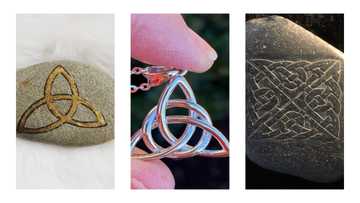Easter symbols: Origins and meanings of the most important symbols
Easter is a Christian holiday that celebrates the resurrection of Jesus Christ. It is rich with symbols that carry deep meaning for believers. The Easter egg and the cross are among the most recognised Easter symbols. The egg stands for new life and the resurrection, while the cross represents the cross on which Jesus was crucified.

Source: UGC
TABLE OF CONTENTS
- Key takeaways
- Origin of Easter symbols
- What are some of the symbols of Easter?
- What is the origin of the Easter symbol?
- What is the spiritual symbolism of Easter?
- What are the three symbols for Easter?
- What are the colours and symbols of Easter?
- What are the Easter triduum colours and symbols?
- What are some of the main Easter symbols and meanings in catholic?
- What is the pagan symbol for Easter?
- What does Easter symbolize in the LDS?
- Why do we dye Easter eggs?
Key takeaways
- Many Easter symbols, like eggs, lambs, and the cross, have deep roots in both Christian and earlier pagan traditions.
- Each symbol reflects key themes of Easter, such as rebirth, sacrifice, and victory over death.
- Understanding the origins and meanings of Easter symbols adds spiritual depth to the celebration.
Origin of Easter symbols
Many of the Easter symbols have deep roots in ancient myths of rebirth and renewal associated with the cycles of seasons and the triumph of good over evil.
While Easter is a Christian holiday, its traditions have developed over time and have been primarily influenced by various cultures and beliefs.

Read also
Pastor Love explains why he doesn't want his kids to follow in his footsteps in a viral video
What are some of the symbols of Easter?
Many hold deep meaning, but some stand out more than others. The following are key examples often seen in religious Easter symbols, images, and traditions, as organised by various churches in Ghana and worldwide.
1. Eggs

Source: UGC
Easter eggs, often called Paschal eggs, are decorated for the Christian celebration of Easter, which honors the resurrection of Jesus. While eggs have long symbolized rebirth and new life, their meaning in Christianity goes deeper. They represent the empty tomb of Jesus, from which he rose.
2. The bunny
Rabbits have long been connected to fertility due to their ability to produce many offspring in spring. This is why they became a strong symbol of Easter. The idea of the Easter bunny began with tales of a rabbit carrying baskets filled with eggs to share.
This tradition later evolved into the modern Easter bunny known today. The bunny often appears in Easter symbols drawing, especially alongside eggs and spring themes.
3. Lamb
For Christians, the lamb is a powerful symbol of Jesus' sacrifice on the cross. He is often called "the Lamb of God" for offering himself to save others. Eating lamb at Easter is a way to honor this act.
The Old Testament also speaks of a sacrificial lamb when God asks Abraham to offer his son. When studying Easter symbols, origins, and meanings, the Catholic tradition highlights the lamb as a central image of sacrifice, obedience, and redemption.
4. Lilies

Source: UGC
Lilies are frequently used as the focal point of Easter celebrations. According to tales, white lilies sprouted from the ground surrounding Jesus during his final moments on the cross. It is alleged that when his sweat fell to the ground, a lily grew there. Correspondingly, Easter lilies are associated with new life and purity. They represent Jesus' resurrection and the assurance of eternal life.
5. Palm Branches
On Palm Sunday, one week before Easter, Catholic churches give out palm leaves. This honors Jesus' entry into Jerusalem. People once laid branches before him as he rode a donkey. Palms are Easter symbols in Catholic tradition. They stand for peace and victory.
6. Chicks
Chicks are a famous Easter symbol, as evidenced by the prominence of Peeps marshmallow candy. Since baby chicks hatch from an egg, they represent fertility and new life, which are commonly correlated with the spring season and Easter.
7. The empty tomb
An important religious symbol for Easter is the image of Jesus' empty tomb. Its emptiness represents the miracle of the resurrection. It shows God's power to do what no human can. The empty tomb stands for hope, renewal, and the promise of new life for those who follow God's path.
When exploring Easter symbols, origins, and meanings in the Bible, passages reveal how the tomb reflects the core message of resurrection and eternal life.
8. Cross buns

Source: UGC
Cross buns are a conventional Good Friday food in many nations around the globe, as they commemorate the day when Jesus was executed on a cross. This holiday occurs on the Friday before Easter Sunday.
Each bun has a cross on the upper edge to represent the cross on which Jesus died. The typical spices inside the buns are believed to reflect the ones employed to set up Jesus' body for burial.
9. Dogwood trees
Because of their involvement in Jesus' crucifixion, dogwood trees serve as a significant Easter symbol. The wood of a dogwood tree is believed to have been used to construct the cross over which Jesus was crucified.
Although Easter does not occur at the same time each year, these trees generally bloom on or near holidays.
10. The cross
The cross is one of the most powerful and meaningful Easter symbols Christian believers recognize. While crosses can be made from many materials, the plain wooden cross holds special significance during Easter. It closely represents the cross on which Jesus was crucified before being placed in the tomb and rising again three days later.
11. The paschal candle
The Paschal candle is ignited from a new fire during the Easter Vigil at the chapel the evening before Easter Sunday. It is a beeswax candle with a cross, the year, and the Greek writings Alpha and Omega, which stand for the beginning and end of time.

Read also
Positive reactions trail Catholic priest who joined Muslims for prayers to end Ramadan, photos go viral
The Paschal candle is subsequently used to light smaller candles held by church members. This act symbolizes the spreading of Jesus' light to everyone in attendance and beyond.
12. The butterfly

Source: UGC
The butterfly Easter symbol symbolises Jesus' resurrection. Just like butterflies arise from their chrysalises, Jesus emerges from the tomb three days after being buried there. They also depict the transition that the Christian faith can bring about through God's grace.
13. Jellybeans
For those who do not enjoy chocolate, jellybeans offer a colorful alternative in Easter baskets. Their oval, egg-like shape makes them a fitting symbol of Easter, while their sugary taste marks the joyful end of Lent.
During World War I, when real eggs were scarce, jellybeans became a popular and tasty replacement, cementing their place in Easter tradition.
14. Soft pretzels
Soft pretzels are closely tied to Easter. A monk is believed to have invented them in the 7th century. They were made for Lent. During this time, Catholics did not eat eggs, milk, or fat. Pretzels are made of only flour, salt, and water. Their shape represents a prayer position.
People once prayed with arms crossed and hands on their shoulders. Pretzels became a popular Lent food in many regions. Today, they still hold meaning, even though fasting rules are less strict.
What is the origin of the Easter symbol?
Originally, Easter commemorated Ishtar, the Assyrian and Babylonian goddess of reproduction and sex. Her characters, such as the bunny and egg, were and continue to be sex and fertility symbols.
What is the spiritual symbolism of Easter?
Easter symbolizes new life, hope, and spiritual renewal. It marks Jesus' resurrection and victory over death. The event offers forgiveness and redemption, reminding believers of God's power and love. Easter brings joy after sorrow and light after darkness. It is a core symbol of faith in Christianity.
What are the three symbols for Easter?
The three main symbols of Easter are the cross, the lamb, and the Paschal candle. The cross represents where Jesus was crucified, died, and was buried. The lamb is a powerful symbol of Jesus sacrificing himself and facing death on the cross.
The Paschal candle is used to light smaller candles held by church members. This act symbolizes the spreading of Jesus' light to all people.

Source: UGC
What are the colours and symbols of Easter?
White, purple, and gold are the three primary Easter colours. Violet and purple colours are commonly utilised throughout the Lenten season leading up to Easter. The most prevalent colours on Easter Sunday are typically gold and white to depict the righteousness and victory of Jesus' resurrection.
What are the Easter triduum colours and symbols?
The colors of vestments and hangings vary across traditions. Some use red, others use black or no color at all. In the Catholic Church, red vestments symbolize the blood of Jesus Christ.
However, in the pre-1970 Roman Missal, the priest wore black. He then changes to violet during the communion part of the service.
What are some of the main Easter symbols and meanings in catholic?
The cross is among the most impactful and significant religious symbols associated with the Catholic Church and Easter.
What is the pagan symbol for Easter?
The most common pagan symbol for Easter is the egg. It stands for fertility, rebirth, and new life. Ancient spring festivals used eggs to celebrate nature’s renewal. The hare or rabbit is another pagan symbol. It also represents fertility. Both symbols come from traditions linked to the spring goddess Ēostre.
What does Easter symbolize in the LDS?
In LDS (Latter-day Saints) belief, Easter symbolizes Jesus Christ’s resurrection and the promise of eternal life. He conquered death so all may live again. Symbols of Easter in the LDS faith include the empty tomb, the lamb, and the cross. These reflect hope, love, and Christ’s sacrifice for all humankind.
Why do we dye Easter eggs?
In Orthodox and Eastern Catholic Churches, Easter eggs are dyed red. The red color represents the blood of Christ. The egg’s hard shell stands for the sealed tomb. Cracking the shell symbolizes Jesus' resurrection from the dead. Each part of the egg carries deep spiritual meaning.
Above are some of the most important Easter symbols and their meanings to reflect on. These symbols have traditionally been used to bring the celebration to life. They help people commemorate the occasion and reflect on the core themes of the Easter story.
Yen.com.gh featured an interesting article on Easter celebration in Ghana and the traditions that make it special. Easter celebration in Ghana is a vibrant mix of religious observances and cultural festivities.
It begins with Palm Sunday processions and culminates in joyful Easter Sunday services full of music and dancing. Special traditions include festive feasts and the Easter Monday Picnic. Learn all about the Easter celebration in Ghana and its traditions.
Source: YEN.com.gh

Tatiana Thiga (Lifestyle writer) Tatiana Thiga is a content creator who joined Yen in 2022. She is an English literature graduate from Kenyatta University. She has amassed sufficient knowledge working on a variety of topics, including biographies, fashion and lifestyles, guides, and more. In 2023, Tatiana finished the AFP course on Digital Investigation Techniques. You can reach her at tatianathiga@gmail.com

Sharon Boit (Lifestyle writer) Sharon J. Boit is a creative writer and researcher with over 10 years of experience. She began her career as a project manager and researcher at the Center for Urban Research and Innovations, University of Nairobi. Sharon has written articles and blog posts for MSN News, Ihamba Adventures, and Industry Biz. She joined Yen.com.gh as a Lifestyle Writer in October 2024, covering entertainment, sports, education, and finance. You can reach Sharon J. Boit by email at boit@gmail.com.







